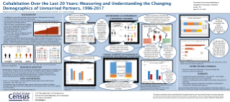Cohabitation Over the Last 20 Years: Measuring and Understanding the Changing Demographics of Unmarried Partners, 1996-2017
Cohabitation Over the Last 20 Years: Measuring and Understanding the Changing Demographics of Unmarried Partners, 1996-2017
Introduction
Cohabitation has more than doubled in the last 20 years, reflecting either increasing normalization or perhaps increasing social disadvantage. Over this same period, the Current Population Survey (CPS) has significantly improved the measurement of cohabiting partners, including a direct cohabitation question in 2007, which revealed partners in “hidden” cohabiting households and cohabiting subfamilies. The goal of this study is to better understand the changing demographics of cohabiters from 1996 to 2017 in light of improved measurement.
Using estimates from the CPS ASEC, this study finds that the inclusion of partners in “hidden” cohabiting households does not significantly shift the overall characteristics of all unmarried partners. However, the inclusion of partners in cohabiting subfamilies does significantly shift certain age, education, and earnings estimates. Because of this, it is recommended to remove partners in cohabiting subfamilies from historical comparisons.
Once partners in cohabiting subfamilies are removed, there is evidence that cohabitation has become normalized over the last 20 years. Comparing 1996 to 2017 estimates, unmarried partners have become: older, more racially diverse, more likely to have never married, more educated, and more likely to earn a higher wage.





